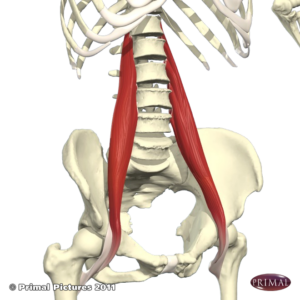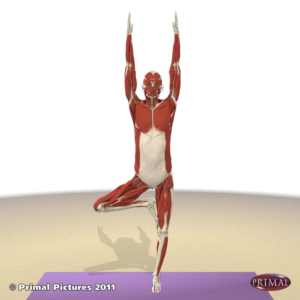 Susi Hately, B.Sc. Kinesiology, C-IAYT
Susi Hately, B.Sc. Kinesiology, C-IAYT
Compensatory patterns are one of my favourite topics to talk about, write about and film. When we reduce compensation, and learn to move more purely, we have better biomechanical integrity, the forces move better through our bodies, and we “transfer load” more efficiently. Ultimately, pain reduces, fatigue lessens and we feel lighter, taller and much more at ease.
To highlight how this concept works, let’s explore one of the Royalties of Compensation – the Psoas muscle, which I affectionately call, The Queen of Compensation.
The Psoas is a deep, strong muscle that cuddles into the lower half of the spine. Specifically, it begins at the 12th thoracic vertebrae, snuggles along each of the 5 lumbar vertebrae and attaches onto the femur at the lesser trochanter. Depending on the source, some consider it to be a primary hip flexor, others describe it as a spinal stabilizer.
Many people often complain that their Psoas feels tight, and feel the need to “stretch it out”. These same people then become frustrated because, while they take time to stretch the “begeezers” out of it, the stretching doesn’t seem to make any difference.
So What Is Up?
To give the Psoas the opportunity to work at its most functional length it needs to have the cooperation of a balanced weight-bearing pelvis. (It also needs a supple rib cage, a well moving skull to spine relationship, and fluid breathing. I will address those relationships in an upcoming blog post). As the pelvis becomes more balanced, the Psoas will be able to provide stability, strength, grounding and centering. Without a balanced weight-bearing pelvis, “stretching” the Psoas will merely be a lesson in frustration.
What is a Balanced Weight-Bearing Pelvis?
A balanced weight-bearing pelvis refers to the state that allows for our upper body to transfer weight or “load” adequately to our lower body. If the weight transfer of the upper body – via head, neck, rib cage and spine – through the hip sockets, legs, knees and feet is inadequate, the Psoas sometimes steps up to provide extra assistance, in an attempt to make up for the imbalance. Unfortunately this is quite inefficient and doesn’t provide much in the way of support or stability. Over time, this inefficiency can lead to problems in the hip joint, misalignment of spinal vertebrae, SI issues, and generally speaking – poor stability and strength.
Balanced Pelvis: A Snapshot
There are several muscles that contribute to a balanced pelvis. They include the hip abductors, hip adductors, hip rotators and pelvic floor. We can also include some of the abdominal muscles as well as the latissmus dorsi, gluteus maximus, quadriceps and hamstrings. How each and/or all of these function will impact how the pelvis “sits” in relationship to the rib cage, spine, skull and limbs. So what to do? How do we address this long list of muscles? Where do we start?
Calming the Compensation and Improving Pure Movement
One of the key concepts I have honed over the years of helping people reduce compensatory patterns and move better, is to recognize that rarely is the issue the actual issue. In this case, my students will tell me that their Psoas is tight, or “behaving badly”. That they have tried multiple things to release it and still it isn’t improving or “doing what it is supposed to do”. This tells me the Psoas, if I can continue to humanize it, is behaving the way it is in response to other forces at play, or in response to what other parts of the body aren’t doing. So my first step is to simply see how the body parts it attaches to are moving. In this case the legs and the spine. Here is a practical example of what I might do with a yoga practitioner.
 Step 1: In standing. I look at how the person is standing and their overall posture. Are their ears over their shoulders, over their hips, over their knees, over their ankles? Is there a twist, a lift, a side shift of one body part relative to another?
Step 1: In standing. I look at how the person is standing and their overall posture. Are their ears over their shoulders, over their hips, over their knees, over their ankles? Is there a twist, a lift, a side shift of one body part relative to another?
Step 2: Bring the right foot into Tree Pose. I am look to see if the right femur is moving purely in the hip socket, if the foot or knee is driving the movement or if the hip joint (femur in hip socket) is actually driving the movement. Does the pelvis move (rotate or tilt), does the spine shift, or does the rib cage move as the right foot makes its way to the left standing leg? How about the skull or the quality of breath? In summary, did their standing posture from step 1 change with the movement into Tree Pose?
Step 3: Repeat to the other side.
This simple movement will highlight where other compensations are showing up. I then will ask my student to move only in the range that those compensations don’t occur. Usually the range becomes much smaller, which can initially bring about the feeling of “you have got to be kidding me“. With a few repetitions, the student begins to feel much more ease, lightness, and a lot more “true stability”. Their other muscles begin to work better because the skeletal segments they are attached to are moving better.
If this seems like an overly simple and straightforward approach to supporting the Psoas to not be in the role of the “Queen of Compensation” it sometimes finds itself in, it’s because it is. Move this way when you are practicing on your mat, and you will see some very cool and perhaps mind blowing changes in how your Psoas feels, not to mention the rest of your body.
And if you aren’t a yoga practitioner? That is okay, I can work with you to support whatever activity you are finding yourself struggling with. The principles are the same.
Enjoy your exploration,
Susi
If you would like to learn more about our upcoming live training in April (in Calgary) or in September (in Toronto), send us a note by clicking here. You can also go directly to the registration page
